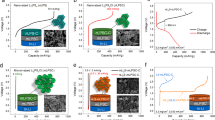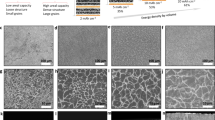Abstract
Accurate understanding of the chemistry of solid-electrolyte interphase (SEI) is key to developing new electrolytes for high-energy batteries using lithium metal (Li0) anodes1. SEI is generally believed to be formed by the reactions between Li0 and electrolyte2,3. However, our new study shows this is not the whole story. Through synchrotron-based X-ray diffraction and pair distribution function analysis, we reveal a much more convoluted formation mechanism of SEI, which receives considerable contributions from electrolyte, cathode, moisture and native surface species on Li0, with highly dynamic nature during cycling. Using isotope labelling, we traced the origin of LiH to electrolyte solvent, moisture and a new source: the native surface species (LiOH) on pristine Li0. When lithium accessibility is very limited as in the case of anode-free cells, LiOH develops into plate-shaped large crystals during cycling. Alternatively, when the lithium source is abundant, as in the case of Li||NMC811 cells, LiOH reacts with Li0 to form LiH and Li2O. While the desired anion-derived LiF-rich SEI is typically found in the concentrated electrolytes or their derivatives, we found it can also be formed in low-concentration electrolyte via the crosstalk effect, emphasizing the importance of formation cycle protocol and opening up opportunities for low-cost electrolyte development.
This is a preview of subscription content, access via your institution
Access options
Access Nature and 54 other Nature Portfolio journals
Get Nature+, our best-value online-access subscription
$29.99 / 30 days
cancel any time
Subscribe to this journal
Receive 12 print issues and online access
$259.00 per year
only $21.58 per issue
Buy this article
- Purchase on Springer Link
- Instant access to full article PDF
Prices may be subject to local taxes which are calculated during checkout




Similar content being viewed by others
Data availability
The data that support the findings of this study are available within the paper and its Supplementary Information. Any other data are available from the corresponding author on request.
References
Cao, X., Jia, H., Xu, W. & Zhang, J.-G. Review—localized high-concentration electrolytes for lithium batteries. J. Electrochem. Soc. 168, 010522 (2021).
Shadike, Z. et al. Engineering and characterization of interphases for lithium metal anode. Chem. Sci. 13, 1547–1568 (2022).
Wu, H., Jia, H., Wang, C., Zhang, J. G. & Xu, W. Recent progress in understanding solid electrolyte interphase on lithium metal anodes. Adv. Energy Mater. 11, 2003092 (2021).
Xu, W. et al. Lithium metal anodes for rechargeable batteries. Energy Environ. Sci. 7, 513–537 (2014).
Niu, C. et al. Balancing interfacial reactions to achieve long cycle life in high-energy lithium metal batteries. Nat. Energy 6, 723–732 (2021).
Niu, C. et al. High-energy lithium metal pouch cells with limited anode swelling and long stable cycles. Nat. Energy 4, 551–559 (2019).
Li, Y. et al. Atomic structure of sensitive battery materials and interfaces revealed by cryo–electron microscopy. Science 358, 506 (2017).
Wang, X. et al. New insights on the structure of electrochemically deposited lithium metal and its solid electrolyte interphases via cryogenic TEM. Nano Lett. 17, 7606–7612 (2017).
Fang, C. et al. Quantifying inactive lithium in lithium metal batteries. Nature 572, 511–515 (2019).
Zachman, M. J., Tu, Z., Choudhury, S., Archer, L. A. & Kourkoutis, L. F. Cryo-STEM mapping of solid-liquid interfaces and dendrites in lithium-metal batteries. Nature 560, 345–349 (2018).
Shadike, Z. et al. Identification of LiH and nanocrystalline LiF in the solid-electrolyte interphase of lithium metal anodes. Nat. Nanotechnol. 16, 549–554 (2021).
Xu, G. et al. The formation/decomposition equilibrium of LiH and its contribution on anode failure in practical lithium metal batteries. Angew. Chem. Int. Ed. 60, 7770–7776 (2021).
Xiang, Y. et al. Quantitatively analyzing the failure processes of rechargeable Li metal batteries. Sci. Adv. 7, eabj3423 (2021).
Wang, C., Meng, Y. S. & Xu, K. Perspective—fluorinating interphases. J. Electrochem. Soc. 166, A5184–A5186 (2019).
Fan, X. et al. Fluorinated solid electrolyte interphase enables highly reversible solid-state Li metal battery. Sci. Adv. 4, eaau9245 (2018).
Suo, L. et al. Fluorine-donating electrolytes enable highly reversible 5-V-class Li metal batteries. Proc. Natl Acad. Sci. USA 115, 1156–1161 (2018).
Busche, M. R. et al. Dynamic formation of a solid-liquid electrolyte interphase and its consequences for hybrid-battery concepts. Nat. Chem. 8, 426–434 (2016).
Lang, S.-Y. et al. Tunable structure and dynamics of solid electrolyte interphase at lithium metal anode. Nano Energy 75, 104967 (2020).
Liu, F. et al. Dynamic spatial progression of isolated lithium during battery operations. Nature 600, 659–663 (2021).
Becking, J. et al. Lithium-metal foil surface modification: an effective method to improve the cycling performance of lithium-metal batteries. Adv. Mater. Interfaces 4, 1700166 (2017).
Leung, K. DFT modelling of explicit solid-solid interfaces in batteries: methods and challenges. Phys. Chem. Chem. Phys. 22, 10412–10425 (2020).
Yamada, Y., Wang, J., Ko, S., Watanabe, E. & Yamada, A. Advances and issues in developing salt-concentrated battery electrolytes. Nat. Energy 4, 269–280 (2019).
Yu, Z. et al. Molecular design for electrolyte solvents enabling energy-dense and long-cycling lithium metal batteries. Nat. Energy 5, 526–533 (2020).
Rietveld, H. A profile refinement method for nuclear and magnetic structures. J. Appl. Crystallogr. 2, 65–71 (1969).
Coelho, A. A. TOPASandTOPAS-Academic: an optimization program integrating computer algebra and crystallographic objects written in C++. J. Appl. Crystallogr. 51, 210–218 (2018).
Zhang, X.-Q. et al. Regulating anions in the solvation sheath of lithium ions for stable lithium metal batteries. ACS Energy Lett. 4, 411–416 (2019).
Verma, P., Maire, P. & Novák, P. A review of the features and analyses of the solid electrolyte interphase in Li-ion batteries. Electrochim. Acta 55, 6332–6341 (2010).
Hu, Y. Y. et al. Origin of additional capacities in metal oxide lithium-ion battery electrodes. Nat. Mater. 12, 1130–1136 (2013).
Li, Z. et al. Understanding the electrochemical formation and decomposition of Li2O2 and LiOH with operando X-ray diffraction. Chem. Mater. 29, 1577–1586 (2017).
Joo, S., Shim, H.-W., Choi, J.-J., Lee, C.-G. & Kim, D.-G. A method of synthesizing lithium hydroxide nanoparticles using lithium sulfate from spent batteries by 2-step precipitation method. Korean J. Met. Mater. 58, 286–291 (2020).
Lorger, S., Narita, K., Usiskin, R. & Maier, J. Enhanced ion transport in Li2O and Li2S films. Chem. Commun. 57, 6503–6506 (2021).
Acknowledgements
S.T., A.C., P.K., X.-Q.Y. and E.H. at BNL are supported by the Assistant Secretary for Energy Efficiency and Renewable Energy (EERE), Vehicle Technology Office (VTO) of the US Department of Energy (DOE) through the Advanced Battery Materials Research (BMR) Program, including Battery500 Consortium under contract no. DE-SC0012704. This research used 28-ID-2 and 7-BM beamlines of the National Synchrotron Light Source II, US DOE Office of Science User Facilities operated for the DOE Office of Science by BNL under contract no. DE-SC0012704. DFT computational work used the resources of the Center for Functional Nanomaterials, a US DOE Office of Science User Facility at BNL, under contract no. DE-SC0012704. J-M.K., J.X., J.L. and X.C. at Pacific Northwest National Laboratory (PNNL) also thank support from EERE and VTO of the US DOE through the BMR program including Battery500 Consortium. The XPS were conducted in the William R. Wiley Environmental Molecular Sciences Laboratory (EMSL), a national scientific user facility sponsored by DOE’s Office of Biological and Environmental Research and located at PNNL. PNNL is operated by Battelle for US DOE under contract DE-AC05-76RL01830. The electrodes used in this study were produced at the US DOE’s CAMP (Cell Analysis, Modelling and Prototyping) Facility, Argonne National Laboratory. The CAMP Facility is fully supported by VTO, EERE of US DOE. K.X. thanks the financial aid from Joint Center of Energy Storage Research, an Energy Hub funded by US DOE, Office of Basic Energy Science.
Author information
Authors and Affiliations
Contributions
S.T., X.C. and E.H. conceived the idea and designed the experiments. B.J.P. provided NMC811 electrodes. S.T. and J.-M.K. carried out electrochemical measurements and prepared interphase samples. S.G. and H.Z. carried out the synchrotron experiments. J.-M.K., N.R., S.S. and X.C. performed the XPS measurements. X.W. did the DFT calculation. S.T., A.C., P.K. and E.H. analysed the XRD and PDF results. S.T., K.X. and E.H. wrote the manuscript with input from all the authors.
Corresponding authors
Ethics declarations
Competing interests
The authors declare no competing interests.
Peer review
Peer review information
Nature Nanotechnology thanks Yong Yang, Xiqian Yu and Guanglei Cui for their contribution to the peer review of this work.
Additional information
Publisher’s note Springer Nature remains neutral with regard to jurisdictional claims in published maps and institutional affiliations.
Supplementary information
Supplementary Information
Supplementary Figs. 1–14, Tables 1 and 2 and Note.
Rights and permissions
Springer Nature or its licensor (e.g. a society or other partner) holds exclusive rights to this article under a publishing agreement with the author(s) or other rightsholder(s); author self-archiving of the accepted manuscript version of this article is solely governed by the terms of such publishing agreement and applicable law.
About this article
Cite this article
Tan, S., Kim, JM., Corrao, A. et al. Unravelling the convoluted and dynamic interphasial mechanisms on Li metal anodes. Nat. Nanotechnol. 18, 243–249 (2023). https://doi.org/10.1038/s41565-022-01273-3
Received:
Accepted:
Published:
Issue Date:
DOI: https://doi.org/10.1038/s41565-022-01273-3



